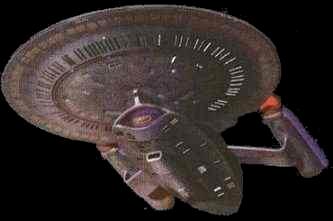
NEW ORLEANS CLASS

|
Type: |
Frigate |
|
Commissioned: |
2364 - present |
|
Dimensions: |
|
|
Length: |
339 m |
|
Beam: |
290 m |
|
Height: |
53 m |
|
Decks: |
14 |
|
Mass: |
900,000 tons |
|
Crew: |
190 |
|
Armament: |
4 x Type VIII phaser arrays, total output 9,500 TeraWatts |
|
3 x Standard photon torpedo tubes + 90 torpedoes |
|
|
Defense Systems: |
Shield system, total capacity 1,012,500 TeraJoules |
|
Standard Duranium/Tritanium single hull |
|
|
Standard level Structural Integrity Field |
|
|
Warp Speeds: |
Normal Cruise: Warp 6 |
|
(TNG Scale) |
Maximum Cruise: Warp 9.2 |
|
Maximum Rated: Warp 9.4 for eight hours |
|
|
Strength Indices: |
Beam Firepower: 190 |
|
(Galaxy Class = 1000) |
Torpedo Firepower: 375 |
|
Weapon Range & Accuracy: 130 |
|
|
Shield Strength: 375 |
|
|
Hull Armor: 50 |
|
|
Speed: 890 |
|
|
Combat Maneuverability: 15000 |
|
|
Overall Strength Index: 335 |
|
|
Diplomatic Capability: |
Grade 3 |
|
Expected Hull Life: |
100 years |
|
Refit Cycle: |
Minor: 1 year |
|
Standard: 5 years |
|
|
Major: 25 years |
|
|
Added Features: |
The New Orleans class was introduced as a counterpart to the large Nebula and Galaxy class starships. The intention was to produce a Frigate which incorporated the technology advances being deployed on these two starships. The New Orleans would also have nearly equal speed to facilitate fleet operations |
|
One unique feature of the New Orleans class is the torpedo arrangement. The ship carries a heavy armament of three torpedo tubes of the most modern type available. When this requirement was issued the design team expressed concerns that the tubes would take up far too much internal volume, necessitating a near 20% reduction in the science capacity of the ship. A reduction to one tube was requested, but Starfleet command rejected the idea. After much consideration, the design team finally decided to mount two of the torpedo tubes in 'bolt-on' modular packs; each module would contain the tube, loading and firing mechanism, supporting power and computer systems, and a magazine of thirty photon torpedoes. The antimatter warhead material is tapped off from the fuel supply as normal and transferred to the pod immediately prior to firing. Computer simulations indicated that the skeleton structure of the Engineering was not sufficient to support a third torpedo pod, so the lower engineering hull was re-designed to include a prominent projection on the underside which provided the extra volume required to house the torpedo tube and loading system - the magazine being housed within the engineering hull proper |
|
|
This ingenious concept not only allowed all three torpedo tubes to be housed within the design, but also permitted a nearly 25% increase in the volume available for other applications within the proper hull. This has allowed most of the major systems to be upgraded; the shield grid of the New Orleans class is one of the most powerful ever installed in a ship of this size. Her maneuverability is also quite impressive, although some vessels have experienced problems with hull stress around the connect points for the torpedo pods. The sensor and computer systems of the New Orleans represent a significant increase in capacity over previous designs |
Home
Crew Intel Office Aliens Ships Technology Protocols General Orders Directives